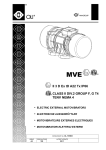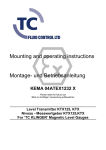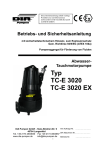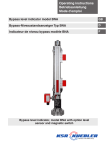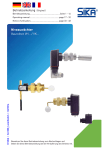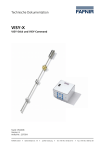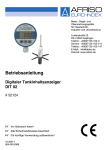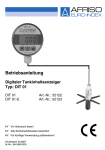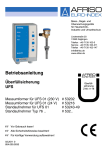Download Operating instructions Betriebsanleitung
Transcript
Operating instructions Betriebsanleitung Level sensor model FFG GB Niveau-Messwertgeber Typ FFG D Level sensor, magnetostrictive measuring principle, model FFG; flange connection D Operating instructions level sensor Model FFG Betriebsanleitung Niveau-Messwertgeber Typ FFG 2 Page 3-22 Seite 23-42 WIKA operating instructions level sensor model FFG 13445627.01 12/2010 GB/D/F GB Contents Contents GB 1. Safety information 4 3. Area of application 9 2. 4. 5. 6. 7. 8. 9. Description of functions and design Assembly Electrical connection Maintenance Trouble shooting Technical specifications Float selection 6 9 13 19 19 20 22 WARNING! Instructions on correct installation and proper operation. Failing to comply with these instructions can lead to malfunction of or damage. 13445627.01 12/2010 GB/D/F DANGER! Instructions which must be complied with to avoid injury or property damage or loss of the type permit. DANGER! Instructions for proper electrical installation. Information Facts and information concerning proper operation. WIKA operating instructions level sensor model FFG 3 1. Safety information 1. Safety information GB Please read these instructions carefully before installing and commissioning the model FFG level sensor system. These instructions are directed to trained personnel implementing the assembly, installation and set-up of the system. The level sensor serves for indicating the level of liquids in containers. Use it for no purpose other than this! No liability will be assumed by Manufacturer for damage resulting from use other than specified! The level sensor has been designed, manufactured and tested in accordance with the state of art and the accepted safety regulations. Notwithstanding this, certain risks might be involved. The following safety instructions should, therefore, be observed: Do not modify, supplement or change the level sensor system unless with Manufacturer’s express approval. Unauthorized changes or non-permitted use will result in immediate loss of warranty or liability claims. The installation, operation and maintenance must be performed by expert and authorized personnel only. The required expertise must be obtained by regular training. The current and voltage values specified for an intrinsically safe operation must be complied with. 4 WIKA operating instructions level sensor model FFG 13445627.01 12/2010 GB/D/F It is imperative for operators, installers and servicers to comply with all applicable safety regulations. This provision shall extend to all local safety and accident preventing regulations not expressly referred to herein. 1. Safety information Prior to starting operation please check all devices for their proper connection, operability and power supply; this shall also apply to assemblies coupled thereto. GB The general operating instructions of all devices as used must be abided by. Measures should be taken preventing personal injuries and damage to property from occurring in case of a defective condition of the level sensor system. The level sensor system must not be operated in the direct vicinity of strong electromagnetic fields (minimum distance: 1 m). The level sensor system must not be exposed to heavy mechanical strain. 13445627.01 12/2010 GB/D/F The maximum power and voltage values for the intrinsically safe operation as specified in the assembling and operating instructions should be adhered to. The safe operation of the system with a view to pressure and temperature of the materials as employed shall be Operator’s responsibility. As even in case of failure, the guide tube does not exhibit a source of ignition there are no objections, in terms of safety, to use the sensor (float and guide tube) as an operating unit of the 1/2 category with containers for combustible fluids (except for carbon disulphide and silicon-organic compounds) under varying atmospheric conditions at excess pressures of up to 25 bar and temperatures of between -60 ... +250 °C. WIKA operating instructions level sensor model FFG 5 1. Safety information / 2. Description of functions ... DANGER! Work in containers involves the danger of intoxication and suffocation. No work is allowed to be carried out unless by taking suitable personal protective measures (e.g. respiratory protection apparatus, protective outfit etc.). GB Danger of explosion Inside the container, there is danger of an explosive atmosphere. Corresponding measures for preventing sparking should be taken. No work is allowed in this area unless by technically skilled staff in accordance with applicable safety regulations. 2. Description of functions and design The design of the level sensor system is shown in figure 1 in the form of embodiment furnished with a screwed-in element. Provided in the probe head (1) is the area of connection and adjustment protected by lid (2). The electrical connection is via an M16x1.5 cable gland (3) at the top of the probe head while the earth connection (4) is at the bottom of the probe head. Seated on the probe tube (5) for vertically adjustable assembling purposes, within the container, is a compression fitting (6) (G 1/2, W 27) or a flange (not shown). The float (7) serves for continuously gauging the product level or interface layer, and is held on the probe tube by a guiding or locking ring (8) etc. 6 WIKA operating instructions level sensor model FFG 13445627.01 12/2010 GB/D/F The WIKA model FFG level sensor acts as a measured value transmitter for high-accuracy, continuous level measurement of liquids and is based on identifying the position of a magnetic float following the magnetostrictive measuring principle. 2. Description of functions and design GB Fig. 1: Level sensor system model FFG 13445627.01 12/2010 GB/D/F The level sensor shown in figure 2 serves for the continuous measurement of fluids. To transmit the liquid level value to the sensor, a float is sliding on the sensor tube. The operating principle of the sensor is based on the magnetostriction effect. The float contains a magnet while a wire made of magnetostrictive material is installed under tension inside the sensor tube. The magnetic field of the float is twisting the wire. A second, temporary magnetic field is generated along the wire by a current pulse within the wire. The superposition of the two magnetic fields will release a mechanical wave on the wire. At the end of the wire within the sensor head, the mechanical wave is converted by a piezo-ceramic transducer into an electrical signal. The starting point of the mechanical wave and, hence, the float position is then determined by measuring the transit time. The results of such measurements are feasibility-tested by a microcontroller located in the sensor head and are then converted into a current value by a digital analog transformer. The sensor is provided with a 2-wire connection so that the current consumption indicates the position of the float at the same time. The current values are restricted to a range of between 3.5 ... 23 mA. WIKA operating instructions level sensor model FFG 7 2. Description of functions and design GB Fig. 2: Functional principle Removal of the transportation packing and transportation safety bolts Carefully remove the level sensor from the transportation packing. Please observe the warning on the shipment packing and remove all transportation safety bolts, prior to discharging the level sensor system. Never remove the level sensor system from the packing by applying force to the guide tube! Prior to assembly the safety bands are to be removed from the floats. Make sure that all packing elements have been removed and that the floats are free to move on the guide tube. 8 WIKA operating instructions level sensor model FFG 13445627.01 12/2010 GB/D/F Transport and storage Transport and storage for level sensors are only allowed in designed packaging. 3. Area of application / 4. Assembly 3. Area of application The level sensor system is available for employment in varying container GB heights of between 200 and 6000 mm. Flange-model or screw-model designs are available allowing a stepless positioning within the container, depending on the design thereof. Probe tube and float can be installed up to the screw element or flange in areas exposed to danger of explosion, in which electric units of the category 1/2 (zone 0) are required. In respect of the bypass model, the complete system is allowed to be installed in areas exposed to danger of explosion that require electric unit of category 2 (zone 1). The sensor head of the level sensor can be operated at ambient temperatures of between -40 ... +85 °C, while the sensor tube is operable within a temperature range of between -25 ... +250 °C. The permitted process temperatures in case of employment in zones subject to danger of explosion that require operating units of categories 1/2 or 2, are set out in the tables. The technical specifications set out in these operating instructions should be observed. 13445627.01 12/2010 GB/D/F 4. Assembly Assembly and servicing in areas exposed to danger of explosion shall be in accordance with the provisions stipulated by ElexV and the Act on Appliance Safety and shall be in accordance with all applicable rules of technology and the present operating instructions. Moreover, please also observe all local safety and accident preventing regulations that have not been expressly mentioned in these operating instructions. Make sure, during assembly that the probe tube is not bent and that the float is not exposed to shock. The level sensor having Ex-approval must be so mounted that the probe head is not located in the Ex-zone 0. WIKA operating instructions level sensor model FFG 9 4. Assembly The level sensor systems, depending on the design thereof, will be mounted into the container by means of a flange or a screw-in thread. Make sure, prior to assembly, that the assembly port provided on GB the container and the attachment means of the level sensor system conform in size and dimension. Depending on the design of the level sensor system, assembly thereof into the container must be externally. Assembly must be in the vertical position. To insure a safe function, the angle of assembly is allowed to differ from the vertical by 30° max. The guide tube of the level sensor is to be externally introduced through the assembly port of the container. Attachment thereof is by tightening the screw-in thread in respect of threaded plugs; by bolting the cap nut in respect of dairy pipe fittings; screwing in respect of flange-model designs or closing of the locking rings (articulated clamp) in triclampmodel clamp connections. ■■ Level sensors having screw-in threads are to be screwed across the entire thread length. ■■ Level sensor systems having dairy pipe fittings are furnished, ex factory, with suitable cap nuts. ■■ Level sensor systems of flange-model design are to be fixed by suitable screws, washers and nuts. ■■ Level sensor systems having clamp connections of the triclamp model are to be secured by means of suitable locking rings (articulated clamp). Suitable sealants should be used. Please make sure that the sealing material is resistant to the fluid and its vapours and to the anticipated temperatures and pressures. In designs having floats mounted thereon the diameters of which exceed the core diameter of the mounting port the floats should be removed from the guide tube prior to assembly thereof. 10 WIKA operating instructions level sensor model FFG 13445627.01 12/2010 GB/D/F Please observe the torque value of the screws! 4. Assembly Fig. 3: Level sensor system with mounting thread 13445627.01 12/2010 GB/D/F GB 1 Terminal box 2 Cable gland 3 Mounting thread 4 Gasket 5 Guide tube 6 Float 7 PTFE washer 8 Set collar or tension clamp Procedure: To mark upper side of floats (e.g. by "top") To mark position of locating rings To remove locating rings and drop protection rings To lift floats To assemble the level sensor To mount floats, locating rings and drop protection rings from inside of container. Please observe markings! ■■ ■■ ■■ ■■ ■■ ■■ The drop protection rings serve to avoid the formation of ignition sparks in the event of an impact of the float on the locating ring. No operation is permitted without the use of drop protection rings. WIKA operating instructions level sensor model FFG 11 4. Montage When using a float made of titanium in areas exposed to danger of explosion of category 1/2, please make sure, during installation and operation, that the said float will generate no sparks caused by friction or shock. GB Maximum lengths of guide tubes Depending on the length and design of the guide tube, the level sensor must be fixed to the container bottom (see table). Guide tube Max. guide tube length L 12 x 1 mm 16 x 1 mm 17.2 x 1.6 mm 18 x 1.5 mm L... 12 660 1270 2100 3000 Version B 3500 6000 6000 6000 Version B: Fixed to the tank ceiling and floor L... WIKA operating instructions level sensor model FFG 13445627.01 12/2010 GB/D/F Version A: Fixed to the tank ceiling Version A 5. Electrical connection 5. Electrical connection The level sensor in areas exposed to danger of explosion GB are allowed to be connected to buffer amplifiers only if these are certificated by a generally accepted test institute, and if the electric specifications thereof are compliant with the following conditions: Ui Ii Pi = ≤ 30 V = ≤ 0.2 A = ≤1W Level sensor model FFG (Standard and pharmaceutical design) EEx ia The electric specifications (see product label) and the additional provisions for installing intrinsically safe circuits should be abided by. No work is allowed to be carried out unless by trained experts. The electric connection of the level sensor is via built-in clamps. The given connecting pattern is conveyed by the connection diagram within the interior of the terminal box, or by the mounting and operating instructions. 13445627.01 12/2010 GB/D/F Selection of connection cable Wiring requires a 2-core cable to be connected in the probe head of the sensor. The cable cross-section must be selected so that the supply voltage on the level sensor is no less than 10 V in the borderline case of maximum current consumption (21.5 mA) in a given cable length L. A copper cable with a cable cross-section of 1 mm² and a length of 100 m (100 m forward and 100 m return line) has a resistance of 3.4 Ω (R = 0.034 Ω x L(m)/F(mm²). WIKA operating instructions level sensor model FFG 13 5. Electrical connection If a supplier provides, for example, 13 V at 21.5 mA, the sum of resistors contained in the supply line is not allowed to be in excess of (13 V – 10 V) / 0.0215 A = 139 Ω. If the cable is of a cross-section of 0.5 mm² and if no burden is contained in the line, the feeder line is not allowed to have a length greater than L = 139 (Ω) x 0.5 (mm²)/0.034 m = 2050 m. GB Note the given connecting pattern The connection should be carried out with light-blue-marked cable. The diameter of the connecting cable must be within the clamping range of the cable gland (5-10 mm). Using other cable diameters involves the danger of moisture ingress. The use of individual strands is not permitted! Cable capacity and inductivity When determining the required cable length, the highest permitted inductivities and capacities of the connected intrinsically safe control unit should be observed. These values are not allowed to be exceeded. Connecting the cable Wiring must be in a voltage-free condition. Compliance with all special VDE regulations and local provisions of installation is imperative. Unscrew lid (1) of probe head with open-end wrench Loosen sleeve nut (2) of cable bolting Insert dual-core cable(4) through sleeve nut and re-tighten the same Connect dual-core cable (4) to screw terminals in probe head, marked by (+) and (-) ■■ Re-screw lid (1) on probe head 14 WIKA operating instructions level sensor model FFG 13445627.01 12/2010 GB/D/F ■■ ■■ ■■ ■■ 5. Electrical connection GB Fig. 4: Electrical connection of the level sensor Observe the general prescriptions of installation! The connections on the separating amplifier are marked accordingly. During connection of the poles, there will be no current flow. Potential balance and PE connection Grounding or potential balance can be via the earth terminal at the bottom side of the probe head. 13445627.01 12/2010 GB/D/F Protect the probe head against the ingress of water! Safe sealing of the cable inlet is safeguarded from a 5 mm outer diameter of the cable. Tighten cable glands. Lock lid of probe head. Wiring of the level sensor for supplying purposes (in Ex, preferably blue cable) is by a dual-core cable. The cable cross-section is to be selected so that the supply voltage to the sensor is no less than 10 V in the borderline case of maximum current consumption (21.5 mA) with a given cable length L. WIKA operating instructions level sensor model FFG 15 5. Electrical connection A copper cable having a length of 100 m (100 m forward and 100 m return line) has a resistance of 3.4 Ω in a cable cross-section of 1 mm². (R = 0.034 Ω x L(m)/F(mm²). If a supplier generates, for example, 13 V GB at 21.5 mA, the resistivity R is allowed to be 3 V/0.0215 A = 139 Ω. If the cable is of a cross-section of 0.5 mm² , the feeder line is allowed to have a length L = R(Ω) x F(mm²)/0.034 m = 2044 m. Connecting pattern in an area exposed to danger of explosion Model FFG (Ex-design Separating amplifier Fig. 5: Connecting diagram of the Ex-design Power supply Minimum voltage: Umin = 10 V + 0.0215 A x ∑R ∑R = Sum of all cable resistancess including feeder line and burden Adjusting measures For further details of adjusting the range of measurement reference (see Fig. 6): ■■ Unscrew lid (1) of probe head with open-end wrench ■■ Keep 4 mA-key (2) pressed for no less than 3 seconds 16 WIKA operating instructions level sensor model FFG 13445627.01 12/2010 GB/D/F Measuring range span Two keys and one illuminated diode (LED) in the connecting area of the probe head serve for adjusting the 4 mA- and 20 mA-points. The level sensor system is adjusted, ex factory, to the maximum range from 4 mA on the probe base to 20 mA at the probe head. The range of measurement for adaptation to the given container can be individually adjusted; however, the distance must be no less than 5 mm. Otherwise the indication direction of the sensor is automatically reversed. 5. Electrical connection The level sensor system now is in the adjusting mode with the green LED (4) "Cal/Err" flashing. The current consumption of the level sensor is 12 mA. Without pressing the key again, the level sensor remains in the GB adjusting mode for 20 seconds before changing back to the measuring mode without modifying the adjustment. To fix the 4 mA point within this period ■■ move the float to the desired position, ■■ and press down key "4 mA" (2) for a short period of time (0.1 ... 2 seconds) 13445627.01 12/2010 GB/D/F The LED display will disappear for 5 seconds, with the current consumption being 4 mA, and thereafter again 12 mA. The level sensor will remain in the adjusting mode for another 15 seconds before changing back to the gauging mode. Fig. 6: Adjustment To fix the 20 mA point within this period ■■ advance the float to the desired position, ■■ and press down key "20 mA" (3) for a short period of time (0.1 ... 2 seconds) WIKA operating instructions level sensor model FFG 17 5. Electrical connection The LED display will disappear for 5 seconds, with the current consumption of the level sensor being 20 mA, and thereafter again 12 mA. The level sensor will remain in the adjusting mode for another 15 seconds GB before changing back to the gauging mode. The new adjustment will not be adopted until it automatically changes from the adjusting mode into the measuring mode (with LED disappearing). For this reason, the level sensor should not be cut off from the current supply before. For adjusting the current consumption in the error mode (see Fig. 5), proceed as follows ■■ unscrew lid (1) of probe head with open-end wrench hold both "4 mA" (2) and "20 mA" keys (3) simultaneously in pressed for a period of time of no less than 3 seconds. The green LED (4) "Cal/Err" is flashing fast, with the current consumption being 16 mA. LED, after 5 seconds, will cease to flash, displaying, for 2.5 seconds, the set error current consumption. Once the LED is permanently illuminated, I error = 21.5 mA; once it extinguishes I error = 3.6 mA. With the key not being pressed down again, the level sensor will remain in the error mode for another 2.5 seconds before changing back into the gauging mode without modifying the adjustment. For setting a current consumption of 3.6 mA during the 10-second dwelling time in the error mode ■■ briefly press down the key "4 mA" key (2) (for 0.1 ... 2 seconds). For adjusting a current consumption of 21.5 mA during the 10-second dwelling time in the error mode ■■ briefly press down the "20 mA" key (3) (for 0.1 ... 2 seconds). The new adjustment will not be adopted by the level sensor until it automatically changes from the adjusting mode to the gauging mode (with LED disappearing). The level sensor should, therefore, not be cut off from the power supply before. 18 WIKA operating instructions level sensor model FFG 13445627.01 12/2010 GB/D/F Current Consumption in the error mode If the level sensor is due to a failure unable to determine a proper float position, i.e. a correct filling level, it will change to an error mode after a short period of time. The current consumption in the error mode has been adjusted, ex factory, to 21.5 mA although it can be switched to 3.6 mA, also. 6. Maintenance / 7. Trouble shooting 6. Maintenance The level transmitters operate free of maintenance and wear when used GB properly. However, within the scope of routine inspections they should undergo visual checks and be part of the container pressure test. 7. Trouble shooting In the following table the most frequent failure causes and the required corrective measures are listed. Trouble Cause Measure of correction No or undefined function Incorrect 0 ... 100 % values 13445627.01 12/2010 GB/D/F Cannot be attached to the proper point within the container Incorrect terminal positioning Insulation secured under terminals Locating rings displaced or incorrectly mounted after removal from the guide tube Float wrongly mounted Incorrect specifications in order Waveguide in defective condition caused by mechanical interference Incorrect setting Thread size or flange size of WFFG-T...EX sensor and container not conforming Thread of attachment sleeve on container in defective condition Screw-in thread on level sensor in defective condition Compare with connecting diagram Check terminal points Check position of locating ring Turn float around Contact factory Return to factory Re-adjust or contact factory Re-design the container Re-design of level sensor in factory Re-work thread or replace mounting socket Return to factory Please give us a call in case of any difficulties. We will do everything we can to provide you with the required advice and help. WIKA operating instructions level sensor model FFG 19 8. Technical specifications 8. Technical specifications Type of protection, explosion and temperature class II 1/2 G EEx ia IIC T6–T2 II 2 D T95 °C IP 6X II 1/2 G EEx ia IIB T6–T2 II 2 D T95 °C IP 6X (pharmaceutical design) Equipment group: Equipment category: Type of protection: Explosive sub-group: Temperature class: II 1G (float and guide tube) 2G / 2D (connecting case) EEx ia IIC or IIB (drop protection PTFE) T2, T3, T4, T5, T6 Summary of electrical specifications of authorized design variants Power supply: Voltage Consumption Inductivity of power (extern. effective) DC 10 ... 30 V max. 700 mW max. 250 μH Permissible data of control unit: Ui Ii Pi Li ≤ 30 V 20 ≤ 200 mA ≤1 ≥ 250 μH Capacity (extern. effective) Type of protection max. 5 nF EEx ia Ci Type of protection ≥ 5 nF EEx ia WIKA operating instructions level sensor model FFG 13445627.01 12/2010 GB/D/F GB 8. Technical specifications Temperatures, standard and pharmaceutical design Tempera- Maximum Maximum ambient Dust maximum surture class process face temperature temperature temperature (sensor head of (sensor head of level GB sensor) level sensor) Category 1/2 T6 -60 ... 60 °C T5 -60 ... 80 °C T4 -60 ... 100 °C T3 -60 ... 150 °C T2 -60 ... 150 °C Category 2 T6 -60 ... 85 °C T5 -60 ... 100 °C T4 -60 ... 135 °C T3 -60 ... 200 °C T2 -60 ... 250 °C -40 ... +40 °C -40 ... +55 °C -40 ... +85 °C -40 ... +85 °C -40 ... +85 °C -40 ... +40 °C -40 ... +55 °C -40 ... +85 °C -40 ... +85 °C -40 ... +85 °C Nominal pressures Process connection Nominal pressure 13445627.01 12/2010 GB/D/F Flanges 1) 2) PN 6 6 bar PN 16 16 bar PN 40 PN 64 150 lbs 300 lbs 600 lbs 25 bar 25 bar 15 bar (max. 148 °C) 25 bar (max. 148 °C) 25 bar (max. 148 °C) These pressures can be applied on use of suitabble: 1. Gaskets 2. Bolts 3. Tensioning rings T≤ +95 °C Triclamp connection per DIN 32676 1) 3) Nom. pressure DN 10 - DN 50 16 bar 0.5 inch - 2 inch DN 65 - DN 100 10 bar 2.5 inch - 4 inch Dairy fitting 1) DN 10 - DN 40 25 bar DN 50 - DN 100 25 bar DN 125 - DN 150 16 bar Mounting thread G1 - G3 1) In cases of maximum bolt threading length and suitable gaskets at the process connection, the float pressure specification applies Ingold-Stutzen 1) DN 25 4 bar If the pressure specifications for the process connection (e.g. flange) and float differ, the lowest pressure figure is then the nominal pressure WIKA operating instructions level sensor model FFG 21 9. Float selection 9. Float selection Spherical floats (K) Cylindrical floats (Z) ØC GB ØC D D E E B B D = Limit S. G. of the medium, immersed float volume 85 % E = Nominal S. G. of the medium, immersed float volume 50 % Material Suits guide tube Ø mm Stainless steel 1.4571 12 12 12 12 18 18 18 18 18 Titanium 3.7035 12 12 12 12 12 18 18 18 18 Stainless steel 1.4571 18 E-CTFE coated 18 18 18 PVC 16 20 Polypropylene 16 20 PVDF 16 20 Pharmaceutical design Stainless steel 1.4435 17.2 Stainless steel 1.4539 17.2 ØA Form ØA B ØC mm mm Max. working pressure bar Max. working temp. mm Limit S. G. 85 % kg/m3 Nominal S. G. 50 % kg/m3 Z K K K K K K K K Z K K K K K K K K K K K K Z Z Z Z Z Z 44 52 62 83 80 98 105 120 120 44 52 52 62 83 80 98 105 120 81 99 106 121 55 80 55 80 55 80 52 52 61 81 76 96 103 117 116 52 52 52 62 81 76 96 103 117 77 97 104 118 54 79 54 79 69 79 15 15 15 15 23 23 23 23 38 15 15 15 15 15 23 23 23 23 22 22 22 22 22 25 22 25 22 25 16 40 32 25 25 25 25 25 25 16 25 110 25 25 25 25 25 25 25 25 25 3 3 3 3 3 3 3 200 200 200 200 200 200 200 200 200 200 250 250 250 250 250 250 250 250 60 60 80 80 100 100 818 769 597 408 679 597 533 389 537 720 707 1040 505 278 665 595 369 329 718 675 633 459 798 537 582 431 821 681 1390 1307 1015 693 1155 1016 907 661 914 1224 1201 1770 859 473 1130 841 627 560 1220 1148 1076 781 1357 974 989 723 1396 1157 K K 80 80 88 76 23 23 16 16 150 150 790 621 1350 1056 °C depending on medium depending on medium depending on medium depending on medium Note: The optimum float will be selected after a feasibility test carried out by WIKA. 22 WIKA operating instructions level sensor model FFG 13445627.01 12/2010 GB/D/F ØA Inhalt Inhalt 1. Sicherheitshinweise 24 3. Einsatzbereich 29 2. 4. 5. 6. 7. 8. 9. Funktionsbeschreibung und Aufbau Montage Elektrischer Anschluss Wartung Fehlersuche Technische Daten Schwimmerauswahl 26 29 33 39 39 40 42 WARNUNG! Hinweise zur fachgerechten Montage und den bestimmungsgemäßen Betrieb. Eine Nichtbeachtung kann zu Fehlfunktionen oder Beschädigungen führen. 13445627.01 12/2010 GB/D/F GEFAHR! Hinweise deren Nichtbeachtung zu Personen- oder Sachschäden führen können. GEFAHR! Angaben für eine fachgerechte elektrische Installation. Information Angaben und Informationen zur sachgerechten Anwendung. WIKA Betriebsanleitung Niveau-Messwertgeber Typ FFG 23 D 1. Sicherheitshinweise 1. Sicherheitshinweise Lesen Sie diese Anleitung, bevor Sie den Messwertgeber Typ FFG installieren und in Betrieb nehmen. Diese Anleitung richtet sich an Fachkräfte, die den Einbau, die Installation und das Einrichten ausführen. Der Messwertgeber dient zur Füllstandmessung von Flüssigkeiten in Behältern. Verwenden Sie ihn ausschließlich für diesen Zweck. Für Schäden, die aus nicht bestimmungsgemäßer Verwendung resultieren, wird vom Hersteller keine Haftung übernommen! Der Messwertgeber wurde entsprechend dem Stand der Technik und den anerkannten sicherheitstechnischen Regeln entwickelt, gefertigt und geprüft. Dennoch können von ihm Gefahren ausgehen. D Beachten Sie deshalb folgende Sicherheitshinweise: Nehmen Sie am Messwertgeber keine Veränderungen, An- oder Umbauten ohne vorherige Genehmigung des Herstellers vor. Unbefugter Eingriff und unzulässige Verwendung führen zum Verlust von Garantie- und Haftungsansprüchen. Bediener, Einrichter und Instandhalter müssen alle geltenden Sicherheitsvorschriften beachten. Dies gilt auch für die örtlichen Sicherheitsund Unfallverhütungsvorschriften, die in dieser Betriebsanleitung nicht genannt sind. Strom- und Spannungswerte für den eigensicheren Betrieb sind einzuhalten. 24 WIKA Betriebsanleitung Niveau-Messwertgeber Typ FFG 13445627.01 12/2010 GB/D/F Die Installation, Bedienung und Instandhaltung darf nur von fachkundigem, autorisiertem Personal ausgeführt werden. Fachkenntnisse müssen durch regelmäßige Schulung erworben werden. 1. Sicherheitshinweise Vor Inbetriebnahme sind alle Geräte auf richtigen Anschluss und Funktion zu prüfen. Die elektrische Versorgung, auch der nachgeschalteten Geräte, ist zu kontrollieren. Die allgemeinen Betriebsanweisungen der verwendeten Geräte sind zu beachten. Es müssen Maßnahmen getroffen werden, die bei einem Defekt der Messwertgeber verhindern, das Gefahren für Personen und Sachen entstehen können. Messwertgeber nicht in unmittelbarer Nähe starker elektromagnetischer Felder betreiben (Abstand min. 1 m). Die Messwertgeber dürfen keiner starken mechanischen Belastungen ausgesetzt werden. 13445627.01 12/2010 GB/D/F Die in der Montage und Betriebsanleitung angegebenen maximalen Strom- und Spannungswerte für den eigensicheren Betrieb sind einzuhalten. Der sichere Betrieb der Anlage im Hinblick auf Druck und Temperatur der verwendeten Stoffe, obliegt dem Betreiber. Da am Geleitrohr auch im Störungsfall keine thermische Zündquelle vorhanden ist, bestehen aus sicherheitstechnischer Sicht keine Bedenken, den Fühler (Schwimmer und Gleitrohr) als Betriebsmittel einer Anwendung der Kategorie 1/2 in Behältern für brennbare Flüssigkeiten (ausgenommen Schwefelkohlenstoff und siliziumorganische Verbindungen) bei abweichenden atmosphärischen Bedingungen mit Überdrück bis 25 bar und Temperaturen zwischen -60 ... +250 °C zu betreiben. WIKA Betriebsanleitung Niveau-Messwertgeber Typ FFG 25 D 1. Sicherheitshinweise / 2. Funktionsbeschreibung ... GEFAHR! Beim Arbeiten in Behältern, besteht Vergiftungs- oder Erstickungsgefahr. Arbeiten dürfen nur unter Anwendung geeigneter Personenschutzmaßnahmen (z. B. Atemschutzgerät, Schutzkleidung o.Ä.). durchgeführt werden. D Achtung Explosionsgefahr Im Behälter besteht die Gefahr explosionsfähiger Atmosphäre. Es sind entsprechende Maßnahmen, die eine Funkenbildung verhindern, zu ergreifen. Arbeiten in diesem Bereich dürfen nur durch Fachpersonal entsprechend den jeweiligen geltenden Sicherheitsrichtlinien durchgeführt werden. 2. Funktionsbeschreibung und Aufbau Der Aufbau des Messwertgebers ist als Ausführung mit Einschraubkörper in Abb. 1 dargestellt. Im Sondenkopf (1) befindet sich der durch den Deckel (2) geschützte Anschluss- und Justagebereich. Der elektrische Anschluss erfolgt über eine M16 x 1,5-Kabelverschraubung (3) oben am Sondenkopf und den Erdungsanschluss (4) unten am Sondenkopf. Auf dem Sondenrohr (5) sitzt zur höhenverstellbaren Montage im Behälter ein Einschraubkörper (6) (Schneidringverschraubung G 1/2, SW 27) oder ein Flansch (nicht dargestellt). Der Schwimmer (7) dient der kontinuierlichen Messung der Produktfüllhöhe oder Trennschicht und wird durch einen Stellring, Sicherungsring (8) usw. auf dem Sondenrohr gehalten. 26 WIKA Betriebsanleitung Niveau-Messwertgeber Typ FFG 13445627.01 12/2010 GB/D/F Der Niveau-Messwertgeber Typ FFG dient als Messwertaufnehmer zur hochgenauen, kontinuierlichen Füllstandserfassung von Flüssigkeiten und basiert auf der Positionsbestimmung eines Magnetschwimmers nach dem magnetostriktiven Messprinzip. 2. Funktionsbeschreibung und Aufbau D Abb. 1: Niveau-Messwertgeber Typ FFG 13445627.01 12/2010 GB/D/F Der in Abb. 2 dargestellte Füllstandsensor dient zur kontinuierlichen Messungen von Flüssigkeiten. Zur Übermittlung des Flüssigkeitsniveaus an den Sensor gleitet ein Schwimmer auf dem Sensorrohr. Das Funktionsprinzip des Sensors nutzt den physikalischen Effekt der Magnetostriktion. Im Schwimmer befindet sich ein Magnet, im Sensorrohr ist ein Draht aus magnetostriktivem Material gespannt. Das Magnetfeld des Schwimmers tordiert den Draht. Ein zweites kurzzeitiges Magnetfeld wird längs des Drahtes durch einen Strompuls im Draht produziert. Die Überlagerung beider Magnetfelder löst eine mechanische Welle auf dem Draht aus. Am Drahtende im Sensorkopf wird die mechanische Welle von einem piezokeramischen Umformer in ein elektrisches Signal umgewandelt. Der Ausgangspunkt der mechanischen Welle und damit die Schwimmerposition wird dann durch eine Laufzeitmessung bestimmt. Die Ergebnisse der Laufzeitmessungen werden von einem Microcontroller im Sensorkopf auf Plausibilität geprüft und mit einem Digital-Analog-Wandler in einen Stromwert umgesetzt. Der Sensor besitzt einen 2-Leiter-Anschluss, daher übermittelt die Stromaufnahme gleichzeitig die Position des Schwimmers. Die Stromaufnahme ist durch die Dimensionierung der Schaltung auf einen Bereich von 3,5 ... 23 mA begrenzt. WIKA Betriebsanleitung Niveau-Messwertgeber Typ FFG 27 2. Funktionsbeschreibung und Aufbau D Abb. 2: Funktionsprinzip Entfernen der Transportverpackung und der Transportsicherungen Den Niveau-Messwertgeber vorsichtig aus der Transportverpackung entfernen. Bitte beachten Sie die auf der Versandverpackung angegebenen Hinweise und entfernen Sie vor der Entnahme alle Transportsicherungen. Den Messwertgeber niemals gewaltsam am Gleitrohr aus der Verpackung entfernen! Vor dem Einbau sind die Sicherungsbänder der Schwimmer zu entfernen. Stellen Sie sicher, dass alle Verpackungsteile entfernt wurden und die Schwimmer auf dem Gleitrohr frei beweglich sind. 28 WIKA Betriebsanleitung Niveau-Messwertgeber Typ FFG 13445627.01 12/2010 GB/D/F Transport und Lagerung Für Transport und Lagerung der Messwertgeber ist die dafür vorgesehene Verpackung zu verwenden. 3. Einsatzbereich / 4. Montage 3. Einsatzbereich Der Niveau-Messwertgeber ist für den Einsatz in unterschiedlichen Behälterabmessungen in Längen ab 200 bis 6000 mm erhältlich. Ausführungen mit Flansch oder mit Verschraubung sind erhältlich. Eine stufenlose Positionierung im Behälter ist je nach Ausführung möglich. D Sondenrohr und Schwimmer können bis zum Einschraubkörper bzw. Flansch in explosionsgefährdeten Bereichen installiert werden, die elektrische Betriebsmittel der Kategorie 1/2 (Zone 0) erfordern. Der Sensorkopf des Füllstandsensors kann bei einer Umgebungstemperatur von -40 ... +85 °C betrieben werden. Das Sensorrohr in einem Bereich von -25 ... +250 °C. Die zulässigen Prozesstemperaturen bei Einsatz in explosionsgefährdeten Zonen, die elektrische Betriebsmittel der Kategorie 1/2 bzw. 2 erfordern, sind den Tabellen zu entnehmen. Die technischen Daten in dieser Betriebsanleitung sind zu beachten. 4. Montage 13445627.01 12/2010 GB/D/F Für Einbau und Instandhaltung in explosionsgefährdeten Bereichen sind die Vorschriften gemäß ElexV und des Gerätesicherheitsgesetzes sowie die allgemein anerkannten Regeln der Technik und diese Betriebsanleitung maßgebend. Beachten Sie auch die örtlichen Sicherheits- und Unfallverhütungsvorschriften, die in dieser Betriebsanleitung nicht genannt sind. Während der Montage ist darauf zu achten, dass das Sondenrohr nicht verbogen wird und der Schwimmer keinen Stoßbelastungen ausgesetzt ist. Der Messwertgeber mit Ex-Zulassung muss so montiert werden, dass sich der Sondenkopf nicht in Ex-Zone 0 befindet. WIKA Betriebsanleitung Niveau-Messwertgeber Typ FFG 29 4. Montage Der Messwertgeber wird je nach Ausführung mittels Flansch oder Einschraubgewinde in den Behälter eingebaut. Vor dem Einbau ist sicherzustellen, dass die im Behälter angebrachte Einbauöffnung und die Befestigungsvorrichtung des Messwertgebers in Größe und Dimensionierung übereinstimmen. D Der Einbau erfolgt je nach Messwertgeber-Ausführung von außen in den Behälter. Messwertgeber sind in einer vertikalen Position einzubauen. Um eine sichere Funktion zu gewährleisten, darf der Einbauwinkel max. 30 ° aus der Vertikalen abweichen. Das Messwertgeber-Gleitrohr ist von Außen durch die Einbauöffnung der Behälters einzuführen. Die Befestigung erfolgt durch Festziehen des Einschraubgewinde bei Gewindestopfen, Aufschrauben der Überwurfmutter bei Milchrohrverschraubungen, Schrauben bei Flanschausführungen bzw. schließen der Spannringe (Gelenkklemme) bei Triclamp Klemmverbinder. ■■ Messwertgeber mit Einschraubgewinde über die volle Gewindelänge eindrehen. ■■ Messwertgeber mit Milchrohrverschraubung sind vom Werk mit einer geeigneten Überwurfmutter ausgestattet. ■■ Messwertgeber mit Flanschausführung sind mittels geeigneter Schrauben, Unterlagscheiben und Muttern zu befestigen. ■■ Messwertgeber mit Triclamp Klemmverbinder mittels geeigneter Spannringe (Gelenkklemme) befestigen. Geeignete Dichtungen verwenden bzw. sicherstellen, dass das Dichtungsmaterial gegen das Medium und dessen Dämpfe, sowie den zu erwartenden Temperatur- und Druckbelastungen beständig ist. Bei Varianten mit aufgesetzten Schwimmern, deren Durchmesser größer ist als der Kerndurchmesser der Einbauöffnung, sind die Schwimmer vor dem Einbau vom Gleitrohr zu entfernen. 30 WIKA Betriebsanleitung Niveau-Messwertgeber Typ FFG 13445627.01 12/2010 GB/D/F Bitte beachten Sie die Drehmomentwerte der Schrauben! 4. Montage Abb. 3: Messwertgeber mit Einschraubgewinde 13445627.01 12/2010 GB/D/F D 1 Anschlussgehäuse 2 Kabelverschraubung 3 Einschraubgewinde 4 Dichtung 5 Gleitrohr 6 Schwimmer 7 PTFE-Scheibe 8 Stellring oder Spannschelle Vorgehensweise: Oberseite der Schwimmer markieren (z. B. mit „Top“) Position der zu entfernenden Stellringe markieren Stellringe und Fallschutzringe entfernen Schwimmer abnehmen Messwertgeber einbauen Schwimmer, Stellringe und Fallschutzringe vom Innern des Behälters aufsetzen. Markierungen beachten! ■■ ■■ ■■ ■■ ■■ ■■ Die Fallschutzringe dienen der Vermeidung von Zündfunken im Falle eines Aufpralles des Schwimmers auf dem Stellring. Ein Betrieb ohne Fallschutzringe ist nicht zulässig. WIKA Betriebsanleitung Niveau-Messwertgeber Typ FFG 31 4. Montage Maximale Gleitrohrlängen Je nach Gleitrohrausführung und -länge muss der Messwertgeber am Behälterboden fixiert werden (siehe Tabelle). Gleitrohr Max. Gleitrohrlänge L 12 x 1 mm 16 x 1 mm 17,2 x 1,6 mm 18 x 1,5 mm Variante A : Befestigung am Tankdach L... 32 Variante A 660 1270 2100 3000 Variante B 3500 6000 6000 6000 Variante B: Befestigung am Tankdach und unten geführt L... WIKA Betriebsanleitung Niveau-Messwertgeber Typ FFG 13445627.01 12/2010 GB/D/F D Bei Einsatz eines Schwimmers aus Titan in explosionsgefährdeten Bereichen der Kategorie 1/2 ist bei Errichtung und Betrieb darauf zu achten, dass dieser Schwimmer keine Reib- und Schlagfunken erzeugen kann. 5. Elektrischer Anschluss 5. Elektrischer Anschluss Der Niveau-Messwertgeber darf in explosionsgefährdeter Umgebung lediglich an Trennverstärker angeschlossen werden, die von einer anerkannten Prüfstelle bescheinigt sind und deren elektrischen Daten die folgenden Bedingungen erfüllen: Ui Ii Pi = ≤ 30 V = ≤ 0,2 A = ≤1W Niveau-Messwertgeber Typ FFG (Standard- und Pharma-Ausführung) EEx ia Die elektrischen Daten (siehe Typenschild) und die zusätzlichen Bestimmungen zum Errichten eigensicherer Stromkreise sind zu beachten. Die Arbeiten dürfen nur von geschultem Fachpersonal vorgenommen werden. Der elektrische Anschluss erfolgt über eingebaute Klemmen. Das jeweilige Anschlussschema ist dem Anschlussbild im Innern des Anschlussgehäuses oder der Montage- und Betriebsanleitung zu entnehmen. 13445627.01 12/2010 GB/D/F Auswahl des Anschlusskabels Für die Verdrahtung benötigen Sie ein 2-adriges Kabel, das im Sondenkopf des Messwertgebers angeschlossen wird. Der Leitungsquerschnitt muss so gewählt werden, dass die Versorgungsspannung am Messwertgeber die 10 V im Grenzfall höchster Stromaufnahme (21,5 mA) bei gegebener Leitungslänge L nicht unterschreitet. Eine Kupferleitung von 100 m (100 m Hin- und 100 m Rückleitung) hat einen Widerstand von 3,4 Ω bei einem Leitungsquerschnitt von 1 mm² (R = 0,034 Ω x L(m)/F(mm²). WIKA Betriebsanleitung Niveau-Messwertgeber Typ FFG 33 D 5. Elektrischer Anschluss Liefert z. B. ein Versorgungsgerät 13 V bei 21,5 mA, dürfen alle in der Versorgungsleitung liegenden Widerstände zusammen höchstens (13 V – 10 V) / 0,0215 A = 139 Ω betragen. Besitzt die Leitung einen Querschnitt von 0,5 mm² und befindet sich keine Bürde in der Leitung, darf die Zuleitung höchstens eine Länge L = 139(Ω) x 0,5(mm²)/ 0,034 m = 2050 m haben. D Das jeweilige Anschlussschema ist zu beachten. Der Anschluss ist mit hellblau gekennzeichnetem Kabel durchzuführen. Der Durchmesser des Anschlusskabels muss innerhalb des Klemmbereichs der Kabeldurchführung (5-10 mm) liegen. Bei der Verwendung anderer Kabeldurchmesser besteht die Gefahr des Eindringens von Feuchtigkeit. Die Verwendung einzelner Litzen ist nicht zulässig! Leitungskapazität und -Induktivität Bei der Ermittlung der erforderlichen Kabellänge sind die maximal zulässigen Induktivitäten und Kapazitäten des angeschlossenen eigensicheren Auswertegerätes zu beachten. Diese Werte dürfen durch das Anschlusskabel nicht überschritten werden. Anschließen des Kabels ■■ Sondenkopfdeckel (1) mit Hilfe eines Maulschlüssels abschrauben ■■ Überwurfmutter (2) der Kabelverschraubung (3) lösen ■■ 2-adriges Kabel (4) in die Überwurfmutter einfädeln und Überwurf- mutter wieder festschrauben ■■ 2-adriges Kabel an die mit (+) und (-) gekennzeichneten Schraub- klemmen am Sondenkopf anschließen ■■ Sondenkopfdeckel (1) wieder aufschrauben 34 WIKA Betriebsanleitung Niveau-Messwertgeber Typ FFG 13445627.01 12/2010 GB/D/F Die Verdrahtung darf nur spannungslos erfolgen. Die besonderen Vorschriften der VDE bzw. die örtlichen Errichtungsvorschriften sind zu beachten. 5. Elektrischer Anschluss D Abb. 4: Elektrischer Anschluss des Niveau-Messwertgebers Beachten Sie die allgemeinen Errichtungsvorschriften! Die Anschlüsse am Trennverstärker sind entsprechend gekennzeichnet. Bei Verpolung des Anschlusses fließt kein Strom. 13445627.01 12/2010 GB/D/F Potentialausgleich und PE-Anschluss Über den Erdungsanschluss an der Unterseite des Sondenkopfes kann die Erdung bzw. der Potentialausgleich vorgenommen werden. Sondenkopf vor eindringendem Wasser schützen! Sichere Abdichtung der Kabeleinführung ab einem Kabelaußendurchmesser von 5 mm. Kabelverschraubung fest verschrauben, Sondenkopfdeckel fest verschließen. Die Verdrahtung vom Füllstandsensor zur Versorgung (bei Ex vorzugsweise blaues Kabel) erfolgt mit einem zweiadrigen Kabel. Der Leitungsquerschnitt muss so gewählt werden, dass die Versorgungsspannung am Messwertgeber die 10 V im Grenzfall höchster Stromaufnahme (21,5 mA) bei gegebener Leitungslänge L nicht unterschreitet. Eine WIKA Betriebsanleitung Niveau-Messwertgeber Typ FFG 35 5. Elektrischer Anschluss Kupferleitung von 100 m (100 m Hin- und 100 m Rückleitung) hat einen Widerstand von 3,4 Ω bei einem Leitungsquerschnitt von 1 mm² (R = 0,034 Ω x L(m)/F(mm²). Liefert z. B. ein Versorgungsgerät 13 V bei 21,5 mA, darf der Widerstand R = 3 V / 0,0215 A = 139 Ω betragen, bei einem Leitungsquerschnitt von 0,5 mm² darf die Zuleitung L = R(Ω) x D F(mm²) / 0,034 m = 2044 m lang sein. Anschlussplan in explosionsgefährdeter Umgebung Typ FFG (Ex-Ausführung) Trennverstärker Abb. 5: Anschlussplan für Ex-Ausführung Hilfsenergie Mindestspannung: Umin = 10 V + 0,0215 A x ∑R ∑R = Summe aller Leitungswiderstände inkl. Zuleitung und Bürde Messbereichsspanne Zur Justage der 4 mA- und 20 mA-Punkte dienen zwei Tasten und eine Leuchtdiode (LED) im Anschlussbereich des Sondenkopfes. Werkseitig ist der Messwertgeber auf die maximale Spanne mit 4 mA am Sondenfuß und 20 mA am Sondenkopf eingestellt. Die Messbereichsspanne kann zur Anpassung an den jeweiligen Behälter individuell eingestellt werden, ein Mindestabstand von 5 mm darf jedoch nicht unterschritten werden. Wird dieser Mindestabstand unterschritten, kehrt sich die Anzeigerichtung des Messwertgebers automatisch um. Zur Justage der Messbereichsspanne (siehe Abb. 6): ■■ Sondenkopfdeckel (1) mit Hilfe eines Maulschlüssels abschrauben ■■ 4 mA-Taste (2) über einen Zeitraum von mindestens 3 Sekunden gedrückt halten 36 WIKA Betriebsanleitung Niveau-Messwertgeber Typ FFG 13445627.01 12/2010 GB/D/F Justierarbeiten 5. Elektrischer Anschluss Der Messwertgeber befindet sich nun im Justiermodus. Die grüne LED (4) „Cal/Err“ blinkt. Die Stromaufnahme des Messwertgebers beträgt 12 mA. Ohne erneuten Tastendruck bleibt der Messwertgeber für 20 Sekunden im Justiermodus, bevor er dann ohne Ändern der Justage zurück in den Messmodus wechseln würde. Zum Festlegen des 4 mA-Punkts binnen dieser Zeitspanne ■■ Schwimmer an die gewünschte Position bewegen ■■ und kurz auf die Taste „4 mA“ (2) drücken (0,1 ... 2 Sekunden) 13445627.01 12/2010 GB/D/F Für 5 Sekunden erlischt die LED, und die Stromaufnahme beträgt 4 mA, danach wieder 12 mA. Der Messwertgeber bleibt für weitere 15 Sekunden im Justiermodus, bevor er ohne Ändern des 20 mA-Punkts zurück in den Messmodus wechseln würde. Abb. 6: Justage Zum Festlegen der 20 mA-Punkts binnen dieser Zeitspanne ■■ Schwimmer positionieren ■■ und kurz auf die Taste „20 mA“ (3) drücken (0,1 ... 2 Sekunden) WIKA Betriebsanleitung Niveau-Messwertgeber Typ FFG 37 D 5. Elektrischer Anschluss Für 5 Sekunden leuchtet die LED, und die Stromaufnahme beträgt 20 mA, danach wieder 12 mA. Der Messwertgeber bleibt für weitere 15 Sekunden im Justiermodus bevor er zurück in den Messmodus wechselt. Die neue Justage wird erst dann übernommen, wenn der Messwertgeber selbsttätig vom Justiermodus in den Messmodus wechselt (LED erlischt). Messwertgeber deswegen nicht vorher von der Stromversorgung trennen. D Stromaufnahme im Fehlermodus Kann der Messwertgeber aufgrund einer Störung keine sinnvolle Schwimmerposition, d.h. keinen korrekten Füllstand erfassen, wechselt er nach kurzer Zeit in einen Fehlermodus. Die Stromaufnahme im Fehlermodus ist werkseitig auf 21,5 mA eingestellt, kann aber auch auf 3,6 mA festgelegt werden. Zur Justage der Stromaufnahme im Fehlermodus (siehe Abb. 5) ben, beide Tasten „4 mA“ (2) und „20 mA“ (3) gleichzeitig über einen Zeitraum von mindestens 3 Sekunden gedrückt halten. Die grüne LED (4) „Cal/Err“ blinkt schnell. Die Stromaufnahme beträgt 16 mA. Nach 5 Sekunden blinkt die LED nicht mehr und zeigt für 2,5 Sekunden die eingestellte Fehlerstromaufnahme an. Leuchtet die LED permanent, so beträgt I Fehler = 21,5 mA, erlischt die LED, so beträgt I Fehler = 3,6 mA. Ohne erneuten Tastendruck bleibt der Messwertgeber für weitere 2,5 Sekunden im Fehlermodus bevor er ohne Ändern der Einstellung zurück in den Messmodus wechseln würde. Zur Einstellung einer Stromaufnahme von 3,6 mA während der 10-sekündigen Verweilzeit im Fehlermodus ■■ kurz auf die Taste „4 mA“ (2) drücken (0,1 ... 2 Sekunden). Zur Einstellung einer Stromaufnahme von 21,5 mA während der 10-sekündigen Verweilzeit im Fehlermodus ■■ kurz auf die Taste „20 mA“ (3) drücken (0,1 ... 2 Sekunden) Die neue Justage wird erst dann übernommen, wenn der Messwertgeber selbsttätig vom Justiermodus in den Messmodus wechselt (LED erlischt). Messwertgeber deswegen nicht vorher von der Stromversorgung trennen. 38 WIKA Betriebsanleitung Niveau-Messwertgeber Typ FFG 13445627.01 12/2010 GB/D/F ■■ Sondenkopfdeckel (1) mit Hilfe eines Maulschlüssels abschrau- 6. Wartung / 7. Fehlersuche 6. Wartung Die Niveau-Messwertgeber arbeiten bei bestimmungsgemäßem Gebrauch wartungs- und verschleißfrei. Sie sind jedoch im Rahmen der regelmäßigen Revision einer Sichtkontrolle zu unterziehen und in die Druckprüfung des Behälters mit D einzubeziehen. 7. Fehlersuche 13445627.01 12/2010 GB/D/F In der folgenden Tabelle sind die häufigsten Fehlerursachen und die erforderlichen Gegenmaßnahmen aufgeführt. Fehler Ursache Maßnahme Keine oder undefinierte Funktion Falsche Klemmenbelegung Vergleich mit Anschlussbild Stellringe verschoben oder nach dem Entfernen vom Gleitrohr falsch aufgesetzt Kontrolle der Lage des Stellringes. Falsche 0 ... 100 % Werte Schwimmer falsch aufgesetzt Falsche Vorgaben bei der Bestellung Wellenleiter durch mechanische Einwirkung defekt Falsch justiert Isolation untergeklemmt Kontrolle der Klemmstellen Schwimmer umdrehen Bitte setzten Sie sich mit dem Werk in Verbindung Rücksendung ans Werk Neu justieren oder setzen Sie sich mit dem Werk in Verbindung Lässt sich Gewindegröße oder Flansch- Umbau des Behälters nicht an der größe des Messwertgebers vorgesehenen und Behälters stimmen nicht Umbau des Messwertgebers Stelle im Behälter überein im Werk befestigen Gewinde der BefestigungsNacharbeiten des Gewindes muffe am Behälter defekt oder Austauschen der Befestigungsmuffe Einschraubgewinde am Rücksendung ans Werk Messwertgeber defekt Rufen Sie uns bei allen Schwierigkeiten an. Wir sind bemüht Ihnen jederzeit mit Rat und Tat zur Seite zu stehen. WIKA Betriebsanleitung Niveau-Messwertgeber Typ FFG 39 8. Technische Daten 8. Technische Daten Zündschutzarten, Explosionsgruppe und Temperaturklasse D II 1/2 G EEx ia IIC T6–T2 II 2 D T95 °C IP 6X II 1/2 G EEx ia IIB T6–T2 II 2 D T95 °C IP 6X (Pharma-Ausführung) II 1G (Schwimmer und Gleitrohr) 2G / 2D (Anschlussgehäuse) Zündschutzart: EEx ia Explosionsuntergruppe: IIC oder IIB (Fallschutz PTFE) Temperaturklasse: T2, T3, T4, T5, T6 Gerätegruppe: Gerätekategorie: Übersicht über die elektrischen Daten der zugelassenen Ausführungsvarianten Hilfsenergie: Spannung Leistungs- Induktivität aufnahme (nach außen wirksam) DC 10 ... 30 V max. 700 mW max. 250 μH Kapazität (nach außen wirksam) Zündschutzart max. 5 nF EEx ia Zulässige Daten des zugehörigen Betriebsmittels: Ui Ii Pi Li Ci Zündschutzart 40 ≤ 200 mA ≤1 ≥ 250 μH ≥ 5 nF EEx ia WIKA Betriebsanleitung Niveau-Messwertgeber Typ FFG 13445627.01 12/2010 GB/D/F ≤ 30 V 8. Technische Daten Temperaturen, Standard- und Pharma-Ausführung Tempera- Maximale Staub (Dust) Maximale Umgeturklasse Prozessbungstemperatur Maximale Oberflätemperatur (Sensorkopf des chentemperatur Füllstandsensors) (Anschlussgehäuse) Kategorie 1/2 T6 -60 ... 60 °C T5 -60 ... 80 °C T4 -60 ... 100 °C T3 -60 ... 150 °C T2 -60 ... 150 °C Kategorie 2 T6 -60 ... 85 °C T5 -60 ... 100 °C T4 -60 ... 135 °C T3 -60 ... 200 °C T2 -60 ... 250 °C -40 ... +40 °C -40 ... +55 °C -40 ... +85 °C -40 ... +85 °C -40 ... +85 °C -40 ... +40 °C -40 ... +55 °C -40 ... +85 °C -40 ... +85 °C -40 ... +85 °C Nenndrücke Prozessanschluss Nenndruck 13445627.01 12/2010 GB/D/F Flansche 1) 2) PN 6 6 bar PN 16 16 bar PN 40 PN 64 150 lbs 300 lbs 600 lbs 25 bar 25 bar 15 bar (max. 148 °C) 25 bar (max. 148 °C) 25 bar (max. 148 °C) Diese Drücke können angewandt werden bei Verwendung geeigneter: 1. Dichtungen 2. Schrauben 3. Gelenkklemmen D T≤ +95 °C Triclamp Klemmverbinder nach DIN 32676 1) 3) Nenndruck DN 10 - DN 50 16 bar 0,5 Zoll - 2 Zoll DN 65 - DN 100 10 bar 2,5 Zoll - 4 Zoll Milchrohrverschraubung 1) DN 10 - DN 40 25 bar DN 50 - DN 100 25 bar DN 125 - DN 150 16 bar Stopfen G1 - G3 1) Bei maximaler Gewindeeinschraublänge und geeigneter Dichtung am Prozessanschluss gilt die Druckangabe des Schwimmers. Ingold-Stutzen 1) DN 25 4 bar Sollten die Druckangaben von Prozessanschluss (z. B. Flansch) und Schwimmer differieren, ist die niederste Druckangabe zu berücksichtigen. WIKA Betriebsanleitung Niveau-Messwertgeber Typ FFG 41 9. Schwimmerauswahl 9. Schwimmerauswahl Kugelschwimmer (K) Zylinderschwimmer (Z) D ØC D D E E B B ØA Werkstoff CrNi-Stahl 1.4571 Titan 3.7035 CrNi-Stahl 1.4571 E-CTFE-beschichtet PVC Polypropylen PVDF 12 12 12 12 18 18 18 18 18 12 12 12 12 12 18 18 18 18 18 18 18 18 16 20 16 20 16 20 Pharma-Ausführung CrNi-Stahl 1.4435 17,2 CrNi-Stahl 1.4539 17,2 E = Nenndichte des Messstoffes, eingetauchtes Schwimmervolumen 50 % ØA Passend Form für Gleitrohr-Ø mm D = Grenzdichte des Messstoffes, eingetauchtes Schwimmervolumen 85 % ØA B ØC mm mm Max. Betriebsdruck bar Max. Betriebstemp. mm °C Grenzdichte 85 % kg/m3 Nenndichte 50 % kg/m3 Z K K K K K K K K Z K K K K K K K K K K K K Z Z Z Z Z Z 44 52 62 83 80 98 105 120 120 44 52 52 62 83 80 98 105 120 81 99 106 121 55 80 55 80 55 80 52 52 61 81 76 96 103 117 116 52 52 52 62 81 76 96 103 117 77 97 104 118 54 79 54 79 69 79 15 15 15 15 23 23 23 23 38 15 15 15 15 15 23 23 23 23 22 22 22 22 22 25 22 25 22 25 16 40 32 25 25 25 25 25 25 16 25 110 25 25 25 25 25 25 25 25 25 3 3 3 3 3 3 3 200 200 200 200 200 200 200 200 200 200 250 250 250 250 250 250 250 250 messstoffabhängig messstoffabhängig messstoffabhängig messstoffabhängig 60 60 80 80 100 100 818 769 597 408 679 597 533 389 537 720 707 1040 505 278 665 595 369 329 718 675 633 459 798 537 582 431 821 681 1390 1307 1015 693 1155 1016 907 661 914 1224 1201 1770 859 473 1130 841 627 560 1220 1148 1076 781 1357 974 989 723 1396 1157 K K 80 80 88 76 23 23 16 16 150 150 790 621 1350 1056 Hinweis: Die Auswahl des optimalen Schwimmers erfolgt nach anwendungstechnischer Prüfung durch WIKA. 42 WIKA Betriebsanleitung Niveau-Messwertgeber Typ FFG 13445627.01 12/2010 GB/D/F ØC WIKA Global Europe Austria WIKA Messgerätevertrieb Ursula Wiegand GmbH & Co. KG 1230 Vienna Tel. (+43) 1 86916-31 Fax: (+43) 1 86916-34 E-Mail: [email protected] www.wika.at Benelux WIKA Benelux 6101 WX Echt Tel. (+31) 475 535-500 Fax: (+31) 475 535-446 E-Mail: [email protected] www.wika.nl Bulgaria WIKA Bulgaria EOOD Bul. „Al. Stamboliiski“ 205 1309 Sofia Tel. (+359) 2 82138-10 Fax: (+359) 2 82138-13 E-Mail: [email protected] 13445627.01 12/2010 GB/D/F Croatia WIKA Croatia d.o.o. Hrastovicka 19 10250 Zagreb-Lucko Tel. (+385) 1 6531034 Fax: (+385) 1 6531357 E-Mail: [email protected] www.wika.hr Finland WIKA Finland Oy 00210 Helsinki Tel. (+358) 9-682 49 20 Fax: (+358) 9-682 49 270 E-Mail: [email protected] www.wika.fi France WIKA Instruments s.a.r.l. 95610 Eragny-sur-Oise Tel. (+33) 1 343084-84 Fax: (+33) 1 343084-94 E-Mail: [email protected] www.wika.fr Germany WIKA Alexander Wiegand SE & Co. KG 63911 Klingenberg Tel. (+49) 9372 132-0 Fax: (+49) 9372 132-406 E-Mail: [email protected] www.wika.de Italy WIKA Italia Srl & C. sas 20020 Arese (Milano) Tel. (+39) 02 9386-11 Fax: (+39) 02 9386-174 E-Mail: [email protected] www.wika.it Poland WIKA Polska S.A. 87-800 Wloclawek Tel. (+48) 542 3011-00 Fax: (+48) 542 3011-01 E-Mail: [email protected] www.wikapolska.pl Romania WIKA Instruments Romania S.R.L. Bucuresti, Sector 5 Calea Rahovei Nr. 266-268 Corp 61, Etaj 1 Tel. (+40) 21 4048327 Fax: (+40) 21 4563137 E-Mail: [email protected] WIKA Betriebsanleitung Niveau-Messwertgeber Typ FFG 43 WIKA Global Russia ZAO WIKA MERA 127015 Moscow Tel. (+7) 495-648 01 80 Fax: (+7) 495-648 01 81 E-Mail: [email protected] www.wika.ru Switzerland Manometer AG 6285 Hitzkirch Tel. (+41) 41 91972-72 Fax: (+41) 41 91972-73 E-Mail: [email protected] www.manometer.ch Serbia WIKA Merna Tehnika d.o.o. Sime Solaje 15 11060 Belgrade Tel. (+381) 11 2763722 Fax: (+381) 11 753674 E-Mail: [email protected] www.wika.co.yu Turkey WIKA Instruments Istanbul Basinc ve Sicaklik Ölcme Cihazlari Bayraktar Bulvari No. 21 34775 Yukari Dudullu - Istanbul Tel. (+90) 216 41590-66 Fax: (+90) 216 41590-97 E-Mail: [email protected] www.wika.com.tr Spain Instrumentos WIKA, S.A. C/Josep Carner, 11-17 08205 Sabadell (Barcelona) Tel. (+34) 902 902577 Fax: (+34) 933 938666 E-Mail: [email protected] www.wika.es Ukraine WIKA Pribor GmbH 83016 Donetsk Tel. (+38) 062 34534-16 Fax: (+38) 062 34534-17 E-Mail: [email protected] www.wika.ua Weitere WIKA Niederlassungen weltweit finden Sie online unter www.wika.de. Further WIKA subsidiaries worldwide can be found online at www.wika.de. WIKA Alexander Wiegand SE & Co. KG Alexander-Wiegand-Straße 30 63911 Klingenberg • Germany Tel (+49) 93 72/132-0 Fax (+49) 93 72/132-406 E-Mail [email protected] www.wika.de 44 WIKA Betriebsanleitung Niveau-Messwertgeber Typ FFG 13445627.01 12/2010 GB/D/F Technical alteration rights reserved. Technische Änderungen vorbehalten.
This document in other languages













































